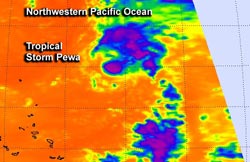NASA Sees Tropical Storm Pewa Temporarily Weaken

NASA's Aqua satellite captured this infrared image of Tropical Storm Pewa (purple) on Aug. 20 at 01:47 UTC/9:47 p.m. EDT, Aug. 19 as it weakened. Coldest cloud top temperatures and strongest storms appear in purple. Image Credit: <br>NASA/JPL, Ed Olsen<br>
The Atmospheric Infrared Sounder or AIRS instrument aboard NASA's Aqua satellite captured an infrared image of Tropical Storm Pewa on Aug. 20 at 01:47 UTC/9:47 p.m. EDT, Aug. 19 as it weakened.
The coldest cloud top temperatures and strongest storms were confined to a small area around the storm's center and in a band of thunderstorms northeast of the center.
Cloud top temperatures in both of those areas were as cold as -63F/-52C. Infrared imagery since this AIRS image has shown that convection has deepened and thunderstorms have become stronger.
At 0900 UTC on Aug. 20, Pewa's maximum sustained winds dropped to 45 knots/51.7 mph/83.3 kph as it faced wind shear. By 1500 UTC/11 a.m. EDT, winds had strengthened to 50 knots/57.5 mph/92.6 kph. Forecasters at the Joint Typhoon Warning Center expect Pewa to strengthen into a typhoon later this week. Pewa was located near 17.5 north and 173.4 east, about 436 nautical miles east-southeast of Wake Island. Pewa is moving to the northwest at 13 knots/15 mph/24 kph and is expected to pass far to the north of Wake Island from Aug. 21 to 22.
Forecasters at the Joint Typhoon Warning Center noted that as Pewa moves through warm ocean waters, a decrease in vertical wind shear will happen over the next couple of days and that will allow for Pewa to strengthen to typhoon force.
Text credit: Rob Gutro
NASA's Goddard Space Flight Center
Media Contact
All latest news from the category: Earth Sciences
Earth Sciences (also referred to as Geosciences), which deals with basic issues surrounding our planet, plays a vital role in the area of energy and raw materials supply.
Earth Sciences comprises subjects such as geology, geography, geological informatics, paleontology, mineralogy, petrography, crystallography, geophysics, geodesy, glaciology, cartography, photogrammetry, meteorology and seismology, early-warning systems, earthquake research and polar research.
Newest articles

Machine learning algorithm reveals long-theorized glass phase in crystal
Scientists have found evidence of an elusive, glassy phase of matter that emerges when a crystal’s perfect internal pattern is disrupted. X-ray technology and machine learning converge to shed light…

Mapping plant functional diversity from space
HKU ecologists revolutionize ecosystem monitoring with novel field-satellite integration. An international team of researchers, led by Professor Jin WU from the School of Biological Sciences at The University of Hong…

Inverters with constant full load capability
…enable an increase in the performance of electric drives. Overheating components significantly limit the performance of drivetrains in electric vehicles. Inverters in particular are subject to a high thermal load,…





















